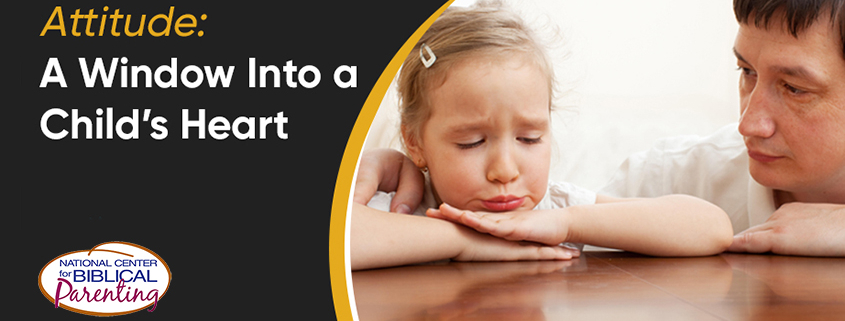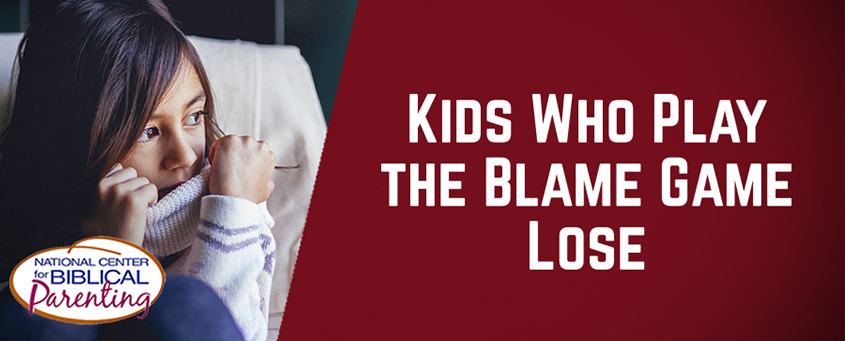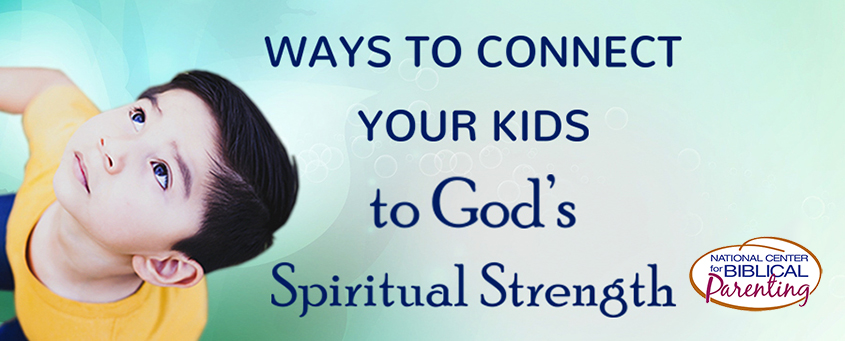Attitude: A Window Into a Child’s Heart

Getting the job done is important, but what about the rolling eyes or huffing and mumbling? Is a bad attitude inevitable? Sometimes parents excuse the attitude by saying, “At least he did what I asked.” Others use excuses like, “She’s tired,” or “He’s only eight” and ignore the attitudes they see.
Unfortunately attitudes don’t typically get better, they get worse. If the heart is in the wrong place, a crisis is just around the corner. Some parents mistakenly ignore attitudes because their children comply. Kids need to learn how to respond well to the challenges of life even when they’re unhappy. We all need to do things we don’t want to do and respond positively even though we don’t feel like it.
3 Aspects of an Attitude
An attitude is more than just the behavior you see. Attitudes are heart issues that have developed from several factors including emotions and thinking errors. Emotions, like frustration, disappointment, and anger, are complicated. Jealousy, pride, and discouragement are likely to reveal themselves inappropriately as well. Often the bad attitude you see in a child is just the tip of the iceberg with complicated and intense emotions swirling around just under the surface.
Thinking errors contribute to bad attitudes as well. Children may believe that just because they’re unhappy they have the right to display that misery to those around them. Furthermore, a child may believe that the workload he has is unreasonable. Your daughter may believe that homework is a waste of time. Another child may think that if his brother is being annoying, he has the right to punch him. Children typically have misperceptions about life leading to thinking errors that result in bad attitudes.
Part of our job as parents is to help children respond appropriately to emotions and to change what they believe about life. One of the ways you’ll do that is by challenging bad attitudes, since bad attitudes are the flag, indicating a heart problem.
Some parents make the mistake of using their own emotions to overpower their kids, believing that, because this child is wrong, then the anger is warranted. In that case, often the parent’s own attitude is revealed, requiring some adjustments in emotional management and a change in thinking.
The reality is that emotional intensity hinders closeness and, just because you’re right in addressing a bad attitude, that doesn’t mean that your anger is a good strategy for dealing with it.
Firmness is One Part of the Solution
So can we put aside our own anger, and still be firm? The answer is yes. Yelling isn’t necessary but firmness is. Let’s remind ourselves that firmness doesn’t mean harshness. You might calmly say, “Wait a minute. Stop right there. Don’t take the trash out. You need to sit down and think about your attitude. I know you have other things to do in life, and you’re disappointed that I asked you to help out here, but you need to be willing to contribute to the family. So sit down and think about it and come back to talk to me when you’re ready.” In this way you challenge a child’s thinking and you check the emotional reaction to raise awareness of a poor response. Having the child take a break gives opportunity to settle down and change the heart.
Of course, changing attitudes takes much time and work, so don’t give up. It’s usually best to sit down with a child at a non-discipline time to talk about attitudes and how they affect the relational atmosphere in a home. When you begin to open dialogue with a child about attitudes, you might point out that attitudes make a statement even though they don’t usually have words. Attitudes are revealed in tone of voice, posture, grunts, sighs, and unkind looks.
An attitude often gives a message that says, “I’m angry with you.” Or “It isn’t fair that I have to do so much work.” Or “How dare you interrupt me before I get to the next level on my video game.”
After a child has settled down from a bad attitude, it’s often helpful to discuss the message the child was communicating. “Son, you were obviously unhappy when I was trying to help you with your homework. What was going on there?”
Even if a child can’t form feelings into words at the moment, your brainstorming session often raises the awareness of non-verbal communication. You’re then helping your child to think about how to better communicate next time and understand that they are loved even when they need correction.
If you regularly talk to your child about attitudes and reflect on poor emotional responses by debriefing, then your child will likely begin to choose different responses. You might even discuss scriptures together about people who had good attitudes compared to those who had bad attitudes.
For example, Cain had a bad attitude toward correction so God confronted him in Genesis 4:6-7 by saying, “Why are you angry? Why is your face downcast? If you do what is right, will you not be accepted? But if you do not do what is right, sin is crouching at your door; it desires to have you, but you must master it.”
Bad Attitudes are a Heart Issue
The same thing is true when children allow their anger to fester. A bad attitude sets a child up to make a poor choice, hurt others, or think selfishly about a situation. When a child responds poorly to a limit you set, an instruction you give, or to correction, then sin is waiting to pounce.
The battle within is an important one for children to understand. Some kids have no idea that they’re wrestling with desires inside. They just freely express their disappointment and many times do it in hurtful ways. The reality is that mature and healthy people put limits on their reactions and choose to do what’s right instead.
Be careful that you don’t just correct for a bad attitude but also look for ways to encourage a positive one. Offer praise for a good attitude under pressure by describing internal strength, not simply right actions.
It’s not hard to show joy or excitement when things are going well. But it’s a real sign of maturity for a child to demonstrate contentment or cooperation in the face of a challenging situation. As you work with your child in the attitude department, you’ll be training and equipping your child for life and letting them learn that correction is a gift.
What thoughts does this article prompt in you? Share your comments below.
For more about how to address attitudes, look at pages 114-141 in the book, Good and Angry: Exchanging Frustration for Character in You and Your Kids.
Here is the Youtube Direct live video :












Leave a Reply
Want to join the discussion?Feel free to contribute!